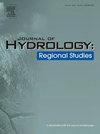A framework to nowcast soil moisture with NASA SMAP level 4 data using in-situ measurements and deep learning
IF 4.7
2区 地球科学
Q1 WATER RESOURCES
引用次数: 0
Abstract
Study Region
Southeast Texas, USA.
Study Focus
NASA's Soil Moisture Active Passive (SMAP) product, particularly the Level 4 (SMAPL4) data, provides high-resolution and extensive coverage of surface and root zone soil moisture (SM), essential for weather and climate research. However, a latency of 2.5–4.0 days in SMAPL4 data limits its real-time hydrologic and weather prediction applications. To address this, we developed a model integrating deep learning (DL) techniques (Long Short-Term Memory, Fully Connected Neural Network) with Principal Component Analysis (PCA) to nowcast SM data in real-time. The model is trained on multi-source SM observations, including near real-time in-situ and satellite data, and deployed over a 56,000+ km² area in southeast Texas.
New Hydrological Insights for the Region
Our DL methodology nowcasts SM accurately in both time and space through real-time assimilation of multi-source data, mitigating SMAP's latency and offering near real-time soil moisture estimates. The nowcasted SM aligns closely with actual SMAPL4 data, capturing spatial and temporal variations. SMAP underestimates the spatio-temporal variability of soil moisture compared to in-situ data, highlighting the necessity for diverse data integration. The proposed framework can improve the real-time flood and drought monitoring and offers insights for various hydrological applications. Nowcasting error mapping identifies regions with higher uncertainties, guiding future model improvements.
利用现场测量和深度学习对 NASA SMAP 第 4 级数据进行土壤湿度预报的框架
研究地区美国得克萨斯州东南部。研究重点美国国家航空航天局的土壤水分主动被动(SMAP)产品,特别是第 4 级(SMAPL4)数据,提供了高分辨率和广泛覆盖的地表和根区土壤水分(SM),对天气和气候研究至关重要。然而,SMAPL4 数据 2.5-4.0 天的延迟限制了其实时水文和天气预报应用。为解决这一问题,我们开发了一种将深度学习(DL)技术(长短期记忆、全连接神经网络)与主成分分析(PCA)相结合的模型,用于实时预报 SM 数据。我们的深度学习方法通过对多源数据的实时同化,在时间和空间上对土壤水分进行了准确的预报,减轻了 SMAP 的延迟,并提供了接近实时的土壤水分估算。现在预测的土壤水分与实际的 SMAPL4 数据密切吻合,捕捉到了空间和时间上的变化。与原位数据相比,SMAP 低估了土壤水分的时空变化,这凸显了多样化数据整合的必要性。所提出的框架可改善实时洪水和干旱监测,并为各种水文应用提供见解。预报误差绘图可确定不确定性较高的区域,从而指导未来模型的改进。
本文章由计算机程序翻译,如有差异,请以英文原文为准。
求助全文
约1分钟内获得全文
求助全文
来源期刊

Journal of Hydrology-Regional Studies
Earth and Planetary Sciences-Earth and Planetary Sciences (miscellaneous)
CiteScore
6.70
自引率
8.50%
发文量
284
审稿时长
60 days
期刊介绍:
Journal of Hydrology: Regional Studies publishes original research papers enhancing the science of hydrology and aiming at region-specific problems, past and future conditions, analysis, review and solutions. The journal particularly welcomes research papers that deliver new insights into region-specific hydrological processes and responses to changing conditions, as well as contributions that incorporate interdisciplinarity and translational science.
 求助内容:
求助内容: 应助结果提醒方式:
应助结果提醒方式:


